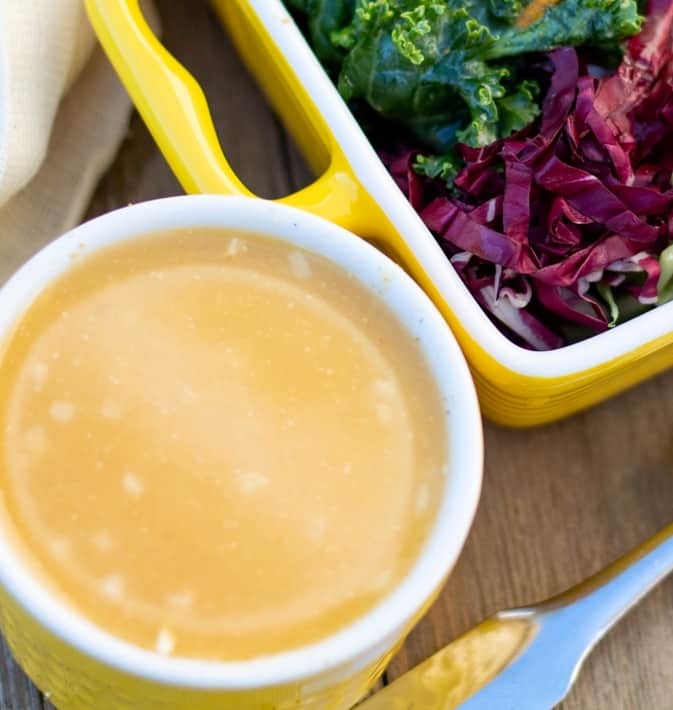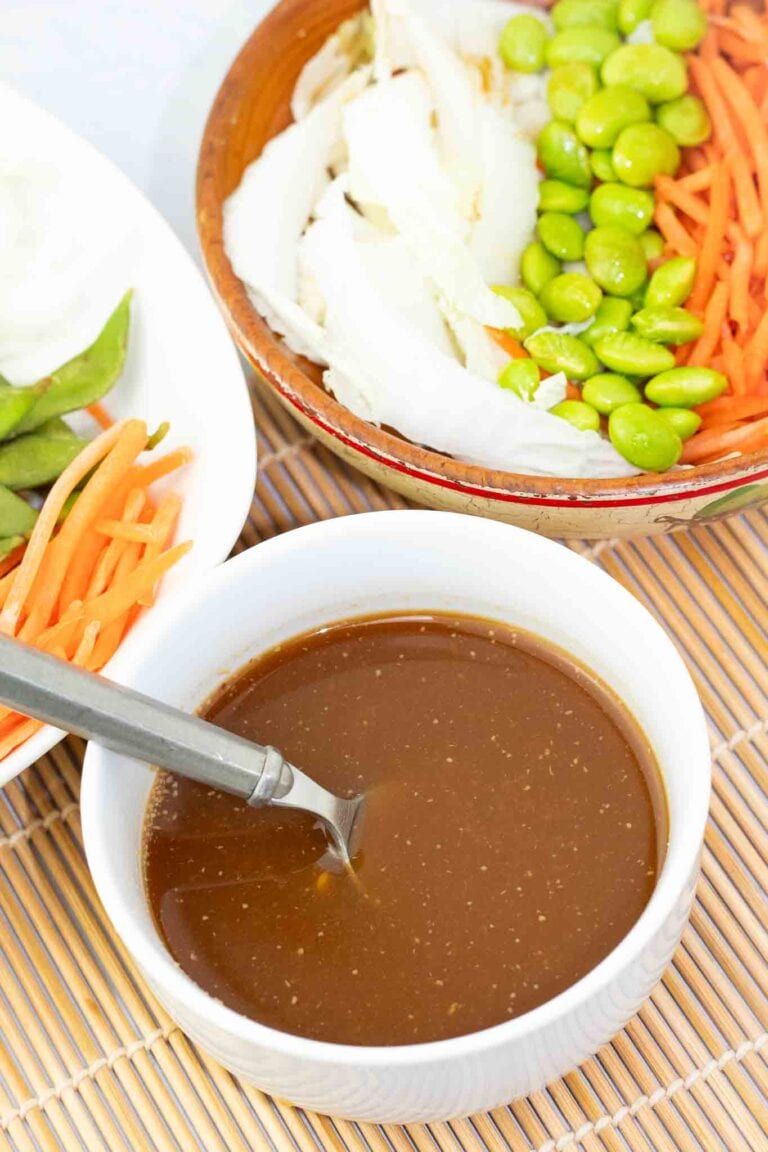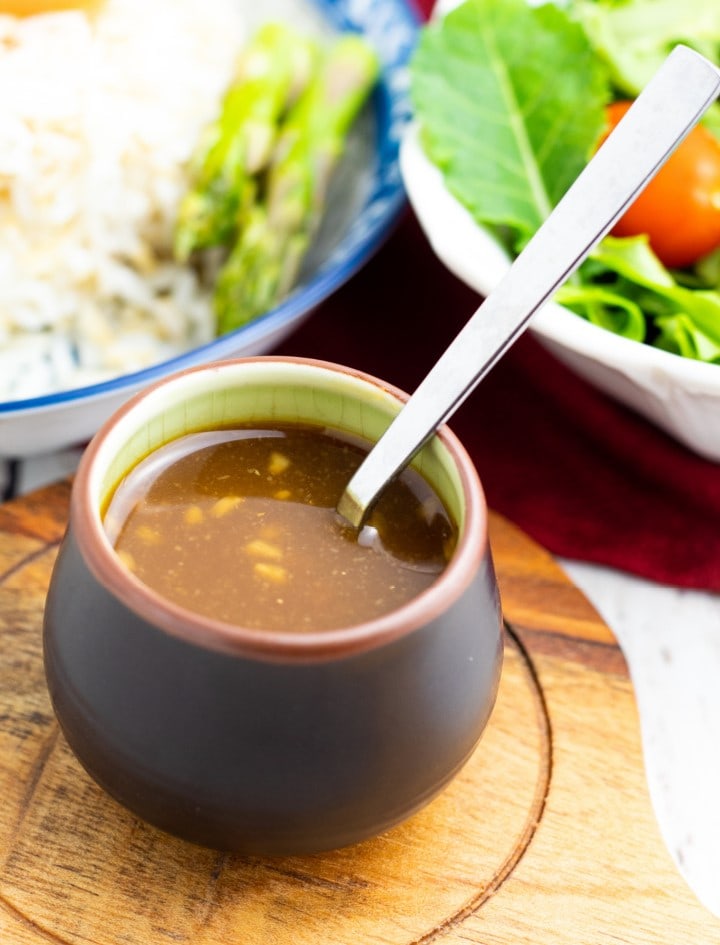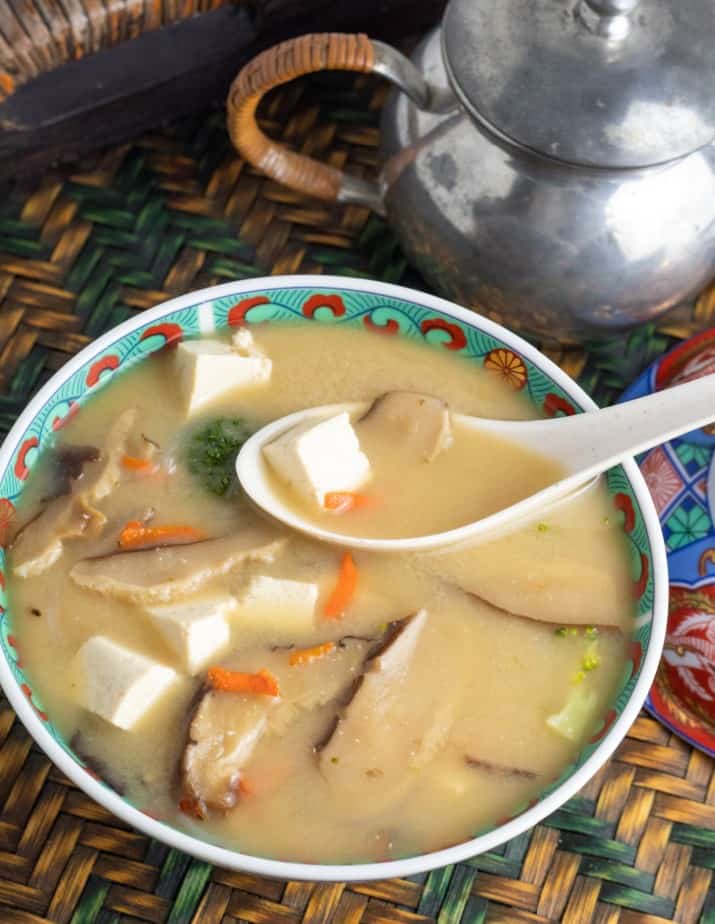Easy Miso Dressing in Minutes
This easy Miso Dressing is a flavor-packed staple for salads, poke bowls, roasted veggies, and more! With its rich umami taste and a tangy kick from apple cider vinegar, it’s the perfect way to elevate any dish. It is dairy-free and oil-free!

I love the savory umami flavor of miso in sauces and dressings. That is why we have others on this site like this simple miso sauce for everything, my oil-free miso-ginger dressing, and our amazing orange miso sauce that will add a delicious citrus flavor to any salad or veggie bowl.
The exciting difference with this miso dressing is that I decided to use aquafaba as an ingredient, and that is a very new thing for me. The aquafaba acts as a natural emulsifier, giving dressings a silky, creamy consistency without the need for oil or dairy. It came out perfectly!
What is miso?
Miso is a savory, umami-packed paste made from fermented soybeans, salt, and koji (a type of mold starter). Originating in Japan, it’s a staple in traditional dishes like soups, marinades, and sauces. Another one of my favorite ways to use it is to make my delicious simple vegan miso soup.
Depending on its fermentation time, miso can range from mild and sweet (white miso) to bold and robust (red miso), giving you endless ways to play with its flavor in the kitchen. For this recipe, I like to use mild white miso paste.
When it comes to sauces, miso is a game-changer. Its rich, salty-sweet depth adds instant complexity, making everything from creamy dressings to tangy glazes irresistible. Plus, it blends beautifully with ingredients like garlic, ginger, or citrus to create sauces that make your veggies, noodles, or veggie grain bowls shine. It’s like having a secret weapon in your pantry for when your dishes need a little extra “wow.”
Beyond its amazing flavor, miso has some impressive health perks. It’s packed with probiotics, which can support gut health and digestion. Just a little dollop can boost not only your meals but also your well-being—delicious and nutritious, all in one!
Ingredients you will need

- Aquafaba- This is simply the juice from cooked chickpeas. Its mild taste blends seamlessly with herbs, spices, and other ingredients, allowing the dressing’s flavors to shine. I love that it gives a creamy texture without any oil.
- Maple syrup- It adds a touch of sweetness to balance tangy or acidic ingredients like vinegar or lemon juice, and its unique, caramel-like taste enhances the complexity of the dressing.
- Soy sauce- It adds a savory umami flavor and a touch of saltiness, enhancing the depth and balance of any salad dressing. I prefer to use low-sodium soy sauce to keep the sodium count down.
- Vinegar- Brings a tangy brightness and subtle sweetness, adding balance and zest to this healthy dressing.
- White miso- This creates a mild a rich umami flavor and creamy depth, making salad dressings more savory and satisfying.
- Garlic- Use fresh garlic or minced from a jar to add a bold, savory kick.
- Hot sauce- Spicing up this dressing is completely optional. I don’t make it spicy hot but add just a small amount for an extra punch of warm flavor.
Substitutions and additions
Soy sauce- To make this sauce gluten-free, swap out soy sauce for tamari, as soy sauce typically contains wheat. Tamari delivers the same savory flavor without the gluten!
Apple cider vinegar- Another option would be rice vinegar or seasoned rice vinegar. Either one will work just as well. Lemon juice is even a good option in a pinch.
Maple syrup- Other sweeteners that could be substituted are agave nectar, honey, or sugar.
Turmeric- Add a dash of ground turmeric to boost the sauce’s vibrant color while also providing its natural anti-inflammatory benefits.
How to make miso dressing

STEP #1: Begin by peeling and mincing the garlic with a knife. This should be approximately one clove.

STEP #2: Originally, I simply added all of the ingredients into a small bowl and whisked it together well. It tasted great, and you can do that. The longer you whisk, the fuller it will get because of the aquafaba.

STEP #2 OPTION: I decided to pour the dressing into my Magic Bullet blender to get a thicker texture, and it worked great.

STEP #3: Blend for less than a minute to get a nice creamy frothy texture. The color becomes a lighter yellow temporarily. It will separate as it sits, so you will need to shake it up before serving.

STEP #4: Give it a taste and adjust any of the ingredients needed to fit your preferences. If you like it sweeter, add more maple syrup. For tangier, add more vinegar. Pour it over a salad, noodles, veggie grain bowls, baked potatoes, and anything else you can think of.
Frequently Asked Questions
You can use any type of miso, but white miso (shiro miso) is great for a milder, slightly sweet flavor. If you prefer something bolder, try yellow or red miso for a deeper, saltier taste.
Miso is naturally salty, so balance it with vinegar (or lemon juice), and add a touch of sweetness with more maple syrup or agave. Taste as you go to find your perfect mix!
Store your miso dressing in an airtight container in the fridge for up to a week. Stir or shake it before use, as some ingredients may separate over time.
Yes! Use gluten-free miso and tamari instead of regular soy sauce to make your miso dressing gluten-free.

Want to Save This Recipe?
Enter your email & I’ll send it to your inbox. Plus, get great new recipes from me every week!
By submitting this form, you consent to receive emails from EatPlant-Based

Easy Miso Dressing
Ingredients
- 1/2 teaspoon white miso paste
- 1 tablespoon low-sodium soy sauce (or tamari for GF)
- 2 tablespoons apple cider vinegar
- 1 tablespoon maple syrup
- 1/3 cup aquafaba
- 1 clove garlic, minced
- 1/8 teaspoon hot sauce or more for spice
Instructions
- Begin by peeling and mincing the garlic with a knife. This should be approximately one clove.
- Orignally, I simply added all of the ingredients into a small bowl and whisked it together well. It tasted great, and you can do that. The longer you whisk, the fuller it will get because of the aquafaba.
- OPTIONALLY: I decided to pour the dressing into my Magic Bullet blender to get a thicker texture, and it worked great. Blend for less than a minute to get a nice creamy frothy texture. The color becomes a lighter yellow temporarily. It will seperate as it sits, so you will need to shake it up before serving.
- Give it a taste and adjust any of the ingredients needed to fit your preferences. If you like it sweeter, add more maple syrup. For tangier, add more vinegar. Pour it over a salad, noodles, veggie grain bowls, baked potatoes, and anything else you can think of.
Video
Notes
- Soy sauce- To make this sauce gluten-free, swap out soy sauce for tamari, as soy sauce typically contains wheat. Tamari delivers the same savory flavor without the gluten!
- Apple cider vinegar- Another option would be rice vinegar or seasoned rice vinegar. Either one will work just as well.
- Maple syrup- Other sweeteners that could be substituted are agave nectar, honey, or sugar.
- Turmeric- Add a dash of ground turmeric to boost the sauce’s vibrant color while also providing its natural anti-inflammatory benefits.
Nutrition
Disclaimer
To obtain the most accurate representation of the nutritional information in a given recipe, you should calculate the nutritional information with the actual ingredients used in your recipe, using your preferred nutrition calculator. You are solely responsible for ensuring that any nutritional information provided is accurate, complete, and useful.
About Terri Edwards
Hi guys! I am the content creator behind EatPlant-Based and a licensed Food for Life instructor with the Physicians Committee for Responsible Medicine. I am passionate about sharing healthy recipes and tips to empower others to get healthy. I’m so glad you’re here! Read More…





